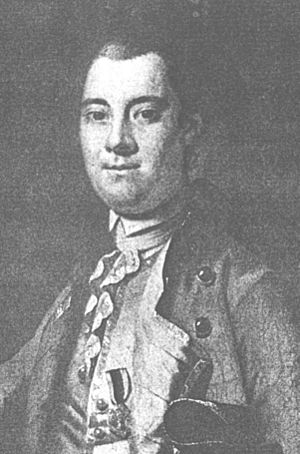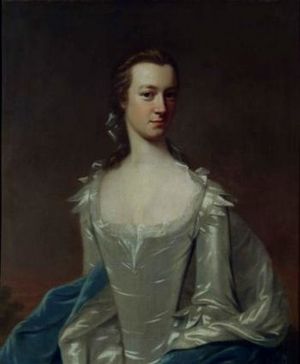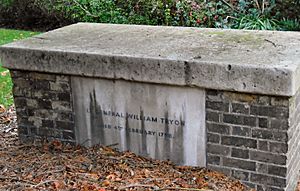William Tryon facts for kids
Quick facts for kids
William Tryon
|
|
|---|---|

Alleged portrait of William Tryon, 1767
|
|
| 39th Governor of New York | |
| In office 1771–1777 |
|
| Monarch | George III |
| Preceded by | Cadwallader Colden (acting) |
| Succeeded by | James Robertson |
| 8th Governor of North Carolina | |
| In office 27 October 1764 – 30 June 1771 |
|
| Monarch | George III |
| Preceded by | Arthur Dobbs |
| Succeeded by | James Hasell (acting) |
| Personal details | |
| Born | 8 June 1729 Norbury Park, England |
| Died | 27 January 1788 (aged 58) London, England |
| Resting place | St Mary's Church, Twickenham |
| Spouse | Margaret Wake |
| Children | 2 |
| Signature | |
| Military service | |
| Allegiance | |
| Branch | British Army |
| Years of service | 1751–1788 |
| Rank | Lieutenant General |
| Commands |
|
| Battles | |
Lieutenant General William Tryon (June 8, 1729 – January 27, 1788) was a British Army general and a colonial official. He served as the governor of New York from 1771 to 1777. Before that, he was the governor of North Carolina from 1764 to 1771.
Contents
Early Life and Military Career

William Tryon was born on June 8, 1729, in Norbury Park, Surrey, England. His family was well-known. In 1751, he joined the military as a lieutenant in the Grenadier Guards. He was promoted to captain later that year. By 1758, he became a lieutenant colonel.
Tryon in the Seven Years' War
During the Seven Years' War, Tryon and his army unit took part in an operation in France. They landed at Cherbourg and destroyed military buildings. In September, they sailed to Saint-Malo. The operation went well until they had to leave. French forces attacked them fiercely at the Battle of Saint Cast. Tryon was injured in his leg and head during this battle.
Governor of North Carolina
On April 26, 1764, Tryon became the acting lieutenant governor of Province of North Carolina. He arrived in North Carolina in October with his family. The previous governor, Arthur Dobbs, was still there. Tryon had no income until Dobbs left.
In 1765, a house called Russelborough was fixed up for Tryon. He became the official acting governor when Dobbs died on March 28, 1765. The King appointed him as governor on July 10.
Expanding the Church of England
As governor, Tryon worked to make the Church of England stronger in North Carolina. There were only five Anglican priests in the colony at that time. Tryon pushed for churches to be finished in towns like Brunswick Town, Wilmington, and New Bern. He appointed priests and encouraged building new churches, especially in country areas.
The Stamp Act and Colonial Resistance
People in North Carolina strongly opposed the Stamp Act of 1765. This act made colonists pay taxes on printed materials. Tryon did not allow the colonial assembly to meet. He wanted to stop them from protesting the Stamp Act.
Tryon said he personally disagreed with the Stamp Act. He even offered to pay the taxes himself for his own documents. He asked for soldiers to enforce the act. However, on June 25, 1766, he learned that the act was canceled.
Building Tryon Palace
Tryon planned a grand governor's mansion. This building would also be the main government center. He worked with architect John Hawks on the plans. In December 1766, the North Carolina legislature approved £5,000 for the mansion. Tryon said this was not enough money. He stated it would cost at least £10,000 to build it simply.
Hawks agreed to manage the building for three years. Tryon sent him to Philadelphia to hire skilled workers. He believed local workers could not build such a complex structure. Tryon convinced the legislature to raise taxes to pay for the project. These new taxes were very unpopular. People started calling the mansion 'Tryon Palace' in a mocking way. Tryon moved into the finished mansion in 1770. It was a very fancy and expensive building for the American colonies.
The Regulator Movement
Tryon helped create a postal service in 1769. However, he is most known for stopping the Regulator Movement. This was an uprising in western North Carolina from 1768 to 1771. The uprising happened partly because of the taxes for Tryon Palace. It was also due to unfair taxes and fraud by local officials.
In May 1771, the conflict became serious. Colonial militia troops defeated 2,000 Regulators at the Battle of Alamance. After the battle, Tryon ordered the execution of seven Regulators. They were found guilty by Judge Richard Henderson. Most were accused of breaking the Riot Act. This crime was temporarily made punishable by death. Six other Regulators were pardoned by King George III and released by Tryon. Some historians see the Regulator uprising as an early sign of the American Revolution. Tryon then raised taxes again to pay for the militia's fight against the Regulators.
Tryon's time as governor ended, and he left North Carolina on June 30, 1771. Tryon Palace was rebuilt in the 1950s using Hawks' original plans.
Governor of New York
On July 8, 1771, Tryon arrived in the Province of New York and became its governor. In 1771 and 1772, he successfully got the assembly to approve money for British troops. They also approved money for a militia on March 18, 1772. Funds were also set aside to rebuild New York City's defenses.
Opposition to the Tea Act
In 1772, there was strong opposition in New York to the Tea Act. In December, the Sons of Liberty convinced tea agents to quit. Tryon suggested landing the tea and storing it at Fort George. The Sons of Liberty were against this. When news of the Boston Tea Party arrived on December 22, Tryon stopped trying to land the tea. He told London that the tea could only be brought ashore with military force. In 1774, New Yorkers dumped their own tea into the harbor.
On December 29, 1773, the governor's mansion in New York and everything inside it were destroyed by fire. The New York Assembly gave him five thousand pounds for his losses.
American Revolutionary War
On April 7, 1774, Tryon traveled to England. Cadwallader Colden was the acting governor while Tryon was away. Tryon returned to New York on June 25, 1775, after the American Revolutionary War had already started. On October 19, 1775, he had to seek safety on a British warship in New York Harbor. He then set up his headquarters on a merchant ship nearby. In 1776, he ended the assembly and called for new elections. The new assembly supported independence, so Tryon dissolved it again.
Military Actions and Raids
In 1776, Tryon and New York City's mayor, David Mathews, planned to capture General George Washington. One of Washington's bodyguards was involved in the plot. The plot was discovered, and the bodyguard was executed for mutiny on June 28, 1776. In June, Admiral Howe arrived in New York City with the British army. Howe put New York under military rule. Tryon kept his title as governor but had little real power.
In early 1777, Tryon became a major-general of the colonial forces. In April, he was ordered to invade Connecticut and march on Danbury. The goal was to destroy military supplies there. Tryon's forces fought and defeated Patriot forces at the Battle of Ridgefield. This happened as they tried to return to their ships in Westport. In May 1778, he became a major-general in the British army. He also became the colonel of the 70th Regiment of Foot. He then became the British commander on Long Island.
Tryon had often suggested attacking civilian areas. However, General Henry Clinton rejected these ideas. In July 1779, Tryon led a series of raids on the Connecticut coast. He attacked New Haven, Fairfield, and Norwalk. He burned and looted most of Fairfield and Norwalk. His raids were meant to draw American forces away from the Hudson River valley. Despite pressure, George Washington did not move his troops. Americans criticized Tryon for attacking civilians. The British commander Clinton was also upset that Tryon disobeyed his orders. Tryon did get approval from Lord George Germain. However, Clinton refused to give Tryon any more important commands. In September 1780, Tryon returned to London, England. He continued to manage his 70th Regiment of Foot, which was still in the colonies. In 1783, he ordered the regiment to return to England to be disbanded. In 1782, he was promoted to lieutenant-general. In 1784, he became the colonel of the 29th Regiment of Foot, which was stationed in Canada.
Death
Tryon died at his home in London on January 27, 1788. He was buried at St Mary's Church, Twickenham, Middlesex, England.
Personal Life
Tryon had a daughter with Mary Stanton, but they never married. In 1757, he married Margaret Wake. She was a wealthy woman from London. Her father, William, had been a governor for the East India Company in Mumbai. Margaret was later honored when Wake County, North Carolina, was named after her. The city of Raleigh is located in Wake County.
Legacy

Some people described Tryon's actions during the American Revolution as very harsh. He was seen as a good administrator who improved the postal service. However, he became unpopular. This was because he followed orders before the war and then acted too harshly during the war.
For example, historian Thomas B. Allen noted that Tryon's "desolation warfare" shocked many British officers and angered American Patriots. Joseph Galloway, a leading Loyalist, said that widespread looting was allowed by the British. He stated that "thousands within the British lines" saw this. In New York City, people accused British soldiers and Loyalists of robbing homes.
Honors
The Cherokee people called Tryon "Wolf." This was because of his work in setting a boundary for them in the western part of the colony.
- Tryon County, New York and Tryon County, North Carolina were both named after him. They were later renamed.
- The town of Tryon, North Carolina
- Tryon Palace in New Bern, North Carolina
- Tryon, Prince Edward Island
- Fort Tryon Park in Manhattan, New York City, is named after him. The British held this fort during most of the American Revolution.
- Tryon Row, a street in lower Manhattan, was named after him for many years.
- Tryon Avenue in the Norwood section of the Bronx
- Tryon Hills is a neighborhood in Charlotte, North Carolina. Tryon Street is a main road in that city.
- Tryon Road in Raleigh, North Carolina (in Wake County, named after Tryon's wife Margaret Wake)
- Tryon Street in Burlington, North Carolina
- Tryon Street in Hillsborough, North Carolina
- Tryon Street in Albany, New York
- Tryon Street in South Glastonbury, Connecticut. Many homes on this street date back to his time.
- Tryon Avenue in Norwalk, Connecticut, runs parallel to the main road Tryon's forces used when they burned Norwalk.
- David Mathews, a former Mayor of New York City, named one of his sons William Tryon Mathews after him.

